Manuel I Komnenos › Michael Psellos » Ancient origins
Articles and Definitions › Contents
- Manuel I Komnenos › Who Was
- Michael Psellos › Who Was
Ancient civilizations › Historical and archaeological sites
Manuel I Komnenos › Who Was
Definition and Origins
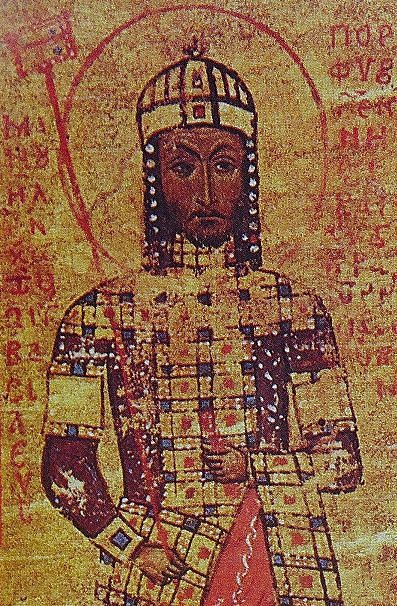
Manuel I Komnenos was emperor of the Byzantine Empire from 1143 to 1180 CE. Manuel continued the ambitious campaigns of his grandfather Alexios I and father John II to aggressively expand the boundaries of his empire. Manuel turned out to be more ambitious than his armies could support and, despite useful treaties and marriage alliances, he ultimately came unstuck with a failed invasion of Italy and then a serious defeat at the hands of the Seljuks in Asia Minor.
SUCCESSION
Manuel inherited the throne of the Byzantine Empire when the reign of his father John II Komnenos came to an unexpected end following the emperor's death in a freak hunting accident on 8 April 1143 CE. Manuel was actually the younger son, but two of his brothers had already died tragically of fever, and John had passed over his elder son Isaac, deeming him unsuitable to rule as he was too easily made angry. John had named Manuel as his successor a few days before he died in Cilicia and the new emperor had been at his father's side. Manuel's immediate problem was to get back to Constantinople before his brother Isaac got any ideas of simply taking the throne by force.
MANUEL WOULD SPEND MOST OF HIS REIGN CAMPAIGNING IN EVERY SINGLE CORNER OF HIS EMPIRE.
Fortunately, Manuel had an invaluable ally who would ensure his first few months as emperor went smoothly. This was John Axoukh, megas domestikos or supreme commander of the army during John II's reign. While Manuel dealt with the funeral arrangements of his father, Axouh dashed off to Constantinople and had Isaac arrested; the Church too was offered a generous annual payment to support the rightful heir. By the time Manuel arrived at his capital a new Patriarch (bishop) had been appointed, and a coronation ceremony was held. Isaac was later released in a typical act of clemency.
The historian JJ Norwich gives the following character description of Byzantium ’s new emperor:
First, he was outstandingly handsome; secondly, there was a charm of manner, a love of pleasure and an enjoyment of life that stood out in refreshing contrast to John's [his father] high-principled austerity. Yet there was nothing shallow about him. A fine soldier and superb horseman, he was, perhaps, too headstrong to be quite the general that his father had been, but there could be no doubting his energy and courage. A skilful diplomat and a born statesman, he remained the typical Byzantine intellectual, cultivated in both the arts and the sciences. (274-5)
One less appreciative section of Byzantine society was the Church. Like many emperors before him, Manuel took a keen interest in ecclesiastical matters, but the Church hierarchy saw this as meddling and was not enamoured either by his overtures to the Popes or the invitation to visit Constantinople he extended to the Seljuk Sultan. In addition, Manuel's reputation as a ladies' man did not go unnoticed. Fortunately for the Church elders, Manuel would spend most of his reign campaigning in every single corner of his empire.
FOREIGN POLICY
Alliances
Unlike his predecessors, Manuel seemed greatly attracted to the west. He favoured Latins in Constantinople, dispensing civil awards and military titles in their direction, and the emperor was even known to have participated in western jousting tournaments (and unseated a couple of Italian knights to boot). Manuel may also have introduced the somewhat indecent western novelty of trousers into Byzantine society. He married twice to princesses from the West - first, Bertha of Sulzbach and then, two years after her death, Maria of Antioch, daughter of the ruler of Antioch Raymond of Poitiers, in 1161 CE. Bertha was the sister-in-law of German king and western emperor Conrad III (r. 1138-1152 CE) and the marriage was arranged by Manuel's father in 1146 CE in order to reinforce the anti-Norman alliance, especially targeted against the Norman king Roger II (r. 1130-1154 CE) in Sicily.
The Second Crusade
After minor victories in Cilicia, Syria, and Asia Minor in 1144-1146 CE, Manuel faced the problem of the Second Crusade of 1147-9 CE. With the goal to secure the Holy Places of Christianity from the Muslims, the Crusaders were held with suspicion by the Byzantines who thought they were really only after the choice parts of the Byzantine Empire. It was for this reason that Manuel insisted the leaders of the crusade swear allegiance to him. At the same time, the western powers considered the Byzantines rather too preoccupied with their own affairs and unhelpful in the noble opportunities they thought a crusade presented.
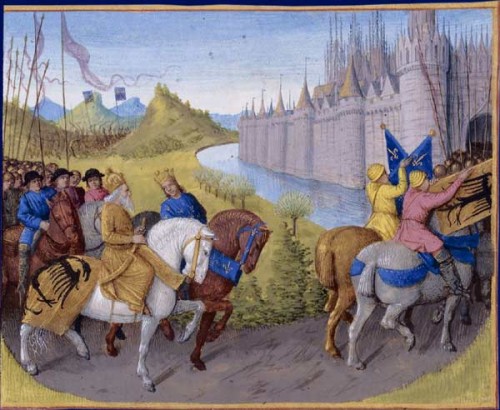
The Second Crusaders Arrive in Constantinople
In more practical terms, as in the First Crusade (1095-1099 CE), the rabble of zealots and men of dubious background seeking absolution which the campaign attracted meant that as soon as the Crusader army hit Byzantine territory on its way east the pillaging, looting, and raping began. This was despite Manuel's insistence to the leaders that all food and supplies be paid for.Manuel provided a military escort to see the Crusaders on their way as quickly as possible, but fighting between the two armed groups was not infrequent. When the French contingent arrived at the Byzantine capital, things worsened still. Always suspicious of the Eastern Church and now outraged to discover Manuel had signed a truce with the Turks (seen by him as less of a threat than the Crusaders in the short term), sections of the army wanted to storm Constantinople.
The Crusaders were, eventually, persuaded to hurry on their way east with reports of a large Muslim army preparing to block their path in Asia Minor. There they ignored Manuel's advice to stick to the safety of the coast and so met disaster and defeat.The Crusade was also a blow to Manuel's carefully constructed diplomatic alliances because, involving Conrad III in person, it provided a distraction which allowed Roger the freedom to attack and pillage Kerkyra ( Corfu ), Euboea, Corinth, and Thebes (where silk and skilled workers were spirited off back to Palermo). Manuel's attempt to persuade Louis VII, the King of France (r. 1137-1180 CE) who was leading the Crusade, to side with him against Roger failed. In 1149 CE the embarrassment of a Serbian uprising and an attack on the area around Constantinople by George of Antioch's fleet were offset by the Byzantines recapturing Kerkyra.
Italy & Barbarossa
From 1155 to 1157 CE the Byzantines invaded Italy, helped by their ally Conrad III, although the German king was by then too ill to participate in person. The family ties between the two rulers had been strengthened by the marriage of Manuel's niece Theodora to Conrad's brother, Duke Henry of Austria. The expedition, despite the acquisition of Bari in 1155 CE, was a failure thanks to stiff resistance from Roger II's successor William I of Sicily (r. 1154-1166 CE) who could also claim the support of Louis VII. Manuel was, essentially, let down by his own fickle mercenaries and gutless local rebels. William was thus able to sign a peace settlement with the Byzantines in 1158 CE through which Manuel recognised William as king.

Byzantine Empire c. 1180 CE
Things got worse for the emperor when Conrad died and he was succeeded by Frederick I Barbarossa (r. 1152-1190 CE) in 1152 CE. The long-standing alliance between the two powers was terminated, largely over the issue of Byzantine support for the Lombards and a squabble over possessions in Hungary. Indeed, the regional alliances were reversed as Manuel's 1158 CE treaty with William also identified Frederick as their common enemy.
In 1172 CE Manuel installed and supported Bela III (r. 1172-1196 CE) on the Hungarian throne and thereby gained the advantage over Frederick. Ties were strengthened further when Manuel had his daughter Maria engaged to Bela, and the Hungarian monarch was given the official title of despot and made heir to the Byzantine throne. When Manuel later had a son of his own, Alexios, the engagement was called off and Alexios was, naturally, nominated as the emperor's official heir.
VENICE HAD PROVIDED SHIPS TO BOLSTER THE BYZANTINE FLEET IN RETURN FOR TRADE PRIVILEGES SINCE 1126 CE.
Venice
Venice had provided ships to bolster the Byzantine fleet in return for trade privileges at Constantinople and within the Byzantine Empire since 1126 CE but by Manuel's reign, the Italian Republic had gained a stranglehold on eastern trade. The emperor, therefore, sought to immediately reverse the situation by confiscating Venetian goods, property and ships, and arresting 10,000 traders throughout the empire in 1171 CE. The official pretext was the accusation that the Venetians had torched the quarter of their rivals the Genoese at Galata.
Alternative Italian states such as Genoa and Pisa were supported instead but the effect on Venetian dominance was negligible and, even worse, Venice sent a fleet to exact revenge. Fortunately for Manuel, who had no fleet to respond with, the Venetians were tricked into waiting out a diplomatic parley, and in the meantime, their crews were struck down by a plague. The Doge was forced to return home where he was stabbed by a mob outraged at his incompetence. Venice would have its revenge, though, as the city led the Fourth Crusade against Constantinople in 1204 CE.
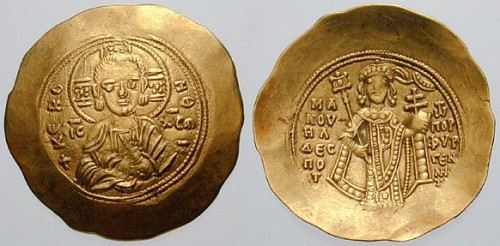
Hyperpyron Coin of Manuel I Komnenos
Myriokephalon
Elsewhere, campaigns went well for Manuel in Armenian Cilicia, Asia Minor, and even against Antioch, still stubbornly in Crusader's hands. On 17 September 1176 CE, though, the emperor suffered a serious defeat at the hands of the Seljuks in Asia Minor, when he was on his way to sack their capital at Iconium. At the battle of Myriokephalon (aka Myriocephalum), Manuel's army was trapped in a narrow pass in the Phrygian mountains and a full massacre was only avoided by the Sultan Kilij Arslan II generously offering a peace deal. The conditions were that the Byzantines abandon the strategic fortresses of Dorylaeum and Sublaeum. With these losses in men and defences, any further Byzantine ambitions in the region were ended and an enemy had been created who would prove more than troublesome in the coming decades. The emperor's reign was now almost over, but there was, typically, one final diplomatic coup. Manuel married off his ten-year-old son Alexios to Agnes, aged nine, daughter of Louis VII.
DEATH & SUCCESSOR
Alexios II Komnenos (r. 1180-1183 CE) inherited the throne following his father's death of natural causes on 24 September 1180 CE, but his reign would be a brief one. In any case too young to rule in his own right, his mother Maria of Antioch acted as his regent, although she favoured her nephew and so Alexios was a mere figurehead. Maria's pro-western policies and preferential treatment to Italian merchants meant that she quickly acquired enemies at court and amongst the wider public. In 1182 CE Andronikos I Komnenos, a cousin of Manuel's, led a successful revolt, a number of Latins were butchered in Constantinople, and the regent and young emperor were ousted. Andronikos forced Alexios to condemn his mother to death, and then, in secret, the boy-emperor was strangled and his body thrown into the sea. Andronikos would only rule himself for two years, after which he was overthrown by a popular uprising.
Manuel's reign, then, had achieved little of lasting substance. He had dazzled at times but really only garnered token victories - expensive ones at that - and whenever his armies were out of sight, the regions turned their back on the emperor and looked after their own interests. The Byzantine Empire had passed its peak and was sailing through troubled waters which would culminate in the terrible storm that was the sack of Constantinople by the Fourth Crusaders in 1204 CE.
Michael Psellos › Who Was
Definition and Origins
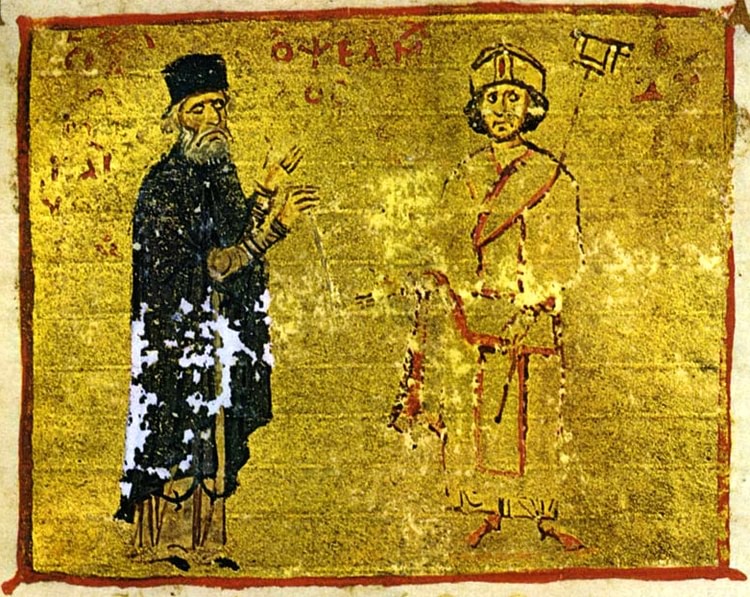
Michael Psellos (1018 - c. 1082 CE) was a Byzantine historian, writer, and intellectual. Michael acted as courtier and advisor to several Byzantine emperors, and he was the tutor of Michael VII. Writing between 1042 and 1078 CE, his texts combine theology, philosophy, and psychology, while his most famous work is the Chronographia, a series of biographies on emperors and empresses, which has proved an invaluable source on the Byzantine Empire of the 11th century CE.
LIFE & WORKS
Born in Constantinople in 1018 CE and given the name Constantine by his aristocratic parents, Michael later changed his name when he joined a monastery mid-career. Prior to that decision he successfully converted his early promise as a child prodigy when he was taught by John Mauropous (a future bishop), rose from the rather low starting point of a judge's clerk, and enjoyed a glittering career in the imperial administration in the capital of the Byzantine Empire, Constantinople. One of the court's intellectuals - and there were many at the time - Michael was an influential writer who combined both philosophy and theology in his letters and books which also encompassed a wide range of other subjects from rhetoric to law, medicine to history. He examined the psychological motivations of friendships and rulership, emphasised the importance of nature ( physis) in human affairs and revived an interest in Neoplatonism. He was a member of the vibrant intellectual scene of Constantinople for decades and counted the city ’s patriarchs (bishops) John VIII Xiphilinos and Constantine Leichoudes as his friends.
Michael, although his long presence at court made him a perfect advisor for many short-reigning emperors, was not always a favourite in every ruler's court in his lifetime. There was a falling-out with the emperor Constantine IX (r. 1042-1055 CE) which led to Michael becoming a monk in a monastery on Mount Olympus. However, in 1045 CE, there was a reconciliation and Constantine made Michael the head of the refounded University of Constantinople. The scholar was given the impressive title of hypatos ton philosophon or Consul of the Philosophers. At the university, he focussed particularly on Rhetoric. Michael wrote widely on an impressive range of topics, for example, publishing his letters, a topography of ancient Athens, a summary of Homer ’s Iliad, a treatise on alchemy, seven eulogies, countless poems, and a comprehensive list of illnesses. Michael died around 1082 CE, although some scholars prefer a later date of 1096 CE.
MICHAEL'S VIVID DESCRIPTIONS OF BYZANTINE EMPERORS EXAMINE WHAT MIGHT HAVE LED TO THE DRAMATIC DECLINE OF THE EMPIRE FOLLOWING THE REIGN OF BASIL II.
CHRONOGRAPHIA
Michael Psellos' most famous work is the Chronographia (' Chronicle ') which covers the history of the Byzantine Empire from 976 to 1078 CE. It seemed that his time at court was mere preparation for his true vocation or, as the historian ERA Sewter puts it in his introduction to his translation of the Chronographia, “the unusual triumphs of a political career are surpassed by his brilliance as a scholar” (14).
Michael's vivid descriptions of Byzantine emperors examine what might have led to the dramatic decline of the empire following the reign of Basil II (976-1025 CE). As an advisor to several emperors and both tutor and then chief minister to Michael VII (r. 1071-1078 CE), Michael was able to draw on personal experience and his privileged access to the imperial court to give a unique insight into Byzantine politics. The historian's influence at court is illustrated by his persuasion of Constantine X (r. 1059-1067 CE) to appoint the previously unfavoured John VIII Xiphilinos patriarch in 1064 CE. Indeed, Michael had contributed to Constantine's accession to the throne. For this reason, perhaps, the work is often a personal one, written in the first person and openly expressing the writer's views. It is also well to remember, though, that Michael, besides being a remarkable scholar, was also “self-seeking, conceited, sanctimonious and untrustworthy” (Norwich, 230), as is obvious from many purple passages of praise in his biographies, and so his history is rarely a wholly objective one.
The Chronographia does lack a military perspective and a wider view of international affairs, focusing as it does on domestic policies and the personalities of the rulers, and how these may have affected their decisions and successes or failures. There is a curious omission of names at times and a definite selection of facts. Michael was also a member of the ruling aristocracy, even if it was the intellectual branch, and the Chronographia does lack any discussion of the lot and role of the peasantry within the Byzantine state. Still, these omissions are not unique for writers of his time, and the work as a whole is one of the most important on Byzantine history that has been handed down to us. Further, Michael himself states in a private letter that the work is not intended to be comprehensive history nor to present the whole truth:
As I say, I am not making any attempt at the moment to investigate the especial circumstances of each event. My object is rather to pursue a middle course between those who recorded the imperial acts of Ancient Rome, on the one hand, and our modern chroniclers, on the other. I have neither aspired to the diffuseness of the former, nor have I sought to imitate the extreme brevity of the latter. (16)
The Chronographia covers the following 14 Byzantine rulers (all quotes are from the ERA Sewter translation):
Basil II (r. 976-1025 CE)
Basil's character was two-fold, for he readily adapted himself no less to the crises of war than to the calm of peace. Really, if the truth be told, he was more of a villain in wartime, more of an emperor in time of peace.Outbursts of wrath he controlled and, like the proverbial “fire under the ashes” kept anger hidden in his heart, but, if his orders were disobeyed in war, on returning to his palace he would kindle his wrath and reveal it. Terrible then was the vengeance he took on the miscreant. (47-8)
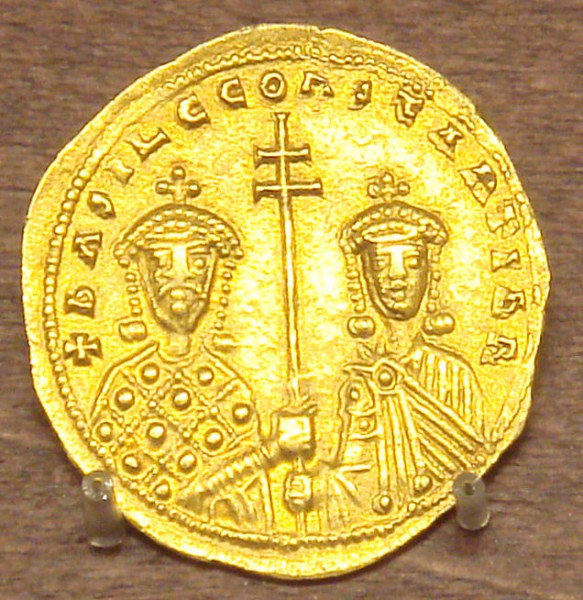
Coin of Basil II
Constantine VIII (r. 1025-1028 CE)
A person of decidedly effeminate character with but one object in life - to enjoy himself to the full. Since he inherited a treasury crammed with money, he was able to follow his natural inclination, and the new ruler devoted himself to a life of luxury. (53)
Romanos III (r. 1028-1034 CE)
He had a graceful turn of speech and a majestic utterance. A man of heroic stature, he looked every inch a king.His idea of his own range of knowledge was vastly exaggerated, but wishing to model his reign on those of the great Antonines of the past, the famous philosopher Marcus and Augustus, he paid attention particularly to two things: the study of letters and the science of war. Of the latter he was completely ignorant, and as for letters, his experience was far from profound. (63-4)
Michael IV (r. 1034-1041 CE)
I am aware that many chroniclers of his life will, in all probability, give an account different from mine, for in his time false opinions prevailed. But I took part in these events, and besides that, I have acquired information of a more confidential nature from men who were his intimate friends…For my own part, when I examine his deeds and compare successes with failures, I find that the former were the more numerous. (109 & 118)
Michael V (r. 1041-1042 CE)
A second peculiarity was the contradiction in the man between heart and tongue - he would think one thing and say something quite different. Men would often stir him to anger and yet meet with a reception of more than usual friendliness when they came to him…There were several examples, of men, who, at dawn the next morning, were destined by him to undergo the most horrible tortures, being made to share his table at dinner, the evening before…The man was a slave to his anger, changeable, stirred to hatred and wrath by any chance happening. (125-6)
Theodora (r. 1042 CE & 1055-1056 CE)
Without the slightest embarrassment she assumed the duties of a man and she abandoned all pretence of acting through her ministers. She herself appointed her officials, dispensed justice from her throne with due solemnity, exercised her vote in the courts of law, issued decrees, sometimes in writing, sometimes by word of mouth. She gave orders, and her manner did not always show consideration for the feelings of her subjects, for she was sometimes more than a little abrupt. (261-2)
Zoe (r. 1042 CE)
Zoe was a woman of passionate interests, prepared with equal enthusiasm for both alternatives - death or life, I mean. In that she reminded me of sea-waves, now lifting a ship on high and then again plunging it down to the depths. (157)
Constantine IX (r. 1042-1055 CE)
In the emperor's case, the people were convinced that some supernatural power foretold him the future: because of this he had more than once shown himself undaunted in time of calamity. Hence, they argued, his contempt of danger and his utter nonchalance. (204)
Michael VI (r. 1056-1057 CE)
In the case of the aged Michael, the conferring of honours surpassed the bounds of propriety. He promoted individuals, not to the position immediately superior to that they already occupied, but elevated them to the next rank and the one above that…His generosity led to a state of absolute chaos. (275-6)
Isaac (r. 1057-1059 CE)
When dealing with ambassadors he pursued no set policy, except that he always held converse with them dressed in the most magnificent apparel. On those occasions he poured out a flood of words, more abundant than the rising Nile in Egypt or Euphrates splashing against the shores of Assyria. He made peace with those who desired it, but with the threat of war if they transgressed so much as one term of his treaty. (306)
Constantine X (r. 1059-1067 CE)
He was a keen student of literature and a favourite saying was this: 'Would that I were better known as a scholar than as emperor!' (344)
Eudokia (r. 1067 CE)
Her pronouncements had the note of authority which one associates with an emperor. Nor was this surprising, for she was in fact an exceedingly clever woman. On either side of her were the two sons, both of whom stood almost rooted to the spot, quite overcome with awe and reverence for their mother. (345)
Romanos IV (r. 1068-1071 CE)
With his usual contempt of all advice, whether on matters civil or military, he at once set out with his army and hurried to Caesarea. Having reached that objective, he was loath to advance any further and tried to find excuses for returning to Byzantium. (354)
Michael VII (r. 1071-1078 CE) - an unfinished biography.
I must first beg my readers not to look upon my version of the man's character and deeds as exaggerated. On the contrary, I shall hardly do justice to either. As I write these words, I find myself overcome by the same emotions as I often feel when I am in his presence: the same wonder thrills me. Indeed, it is impossible for me not to admire him. (367)
LICENSE:
Article based on information obtained from these sources:with permission from the Website Ancient History Encyclopedia
Content is available under License Creative Commons: Attribution-NonCommercial-ShareAlike 3.0 Unported. CC-BY-NC-SA License